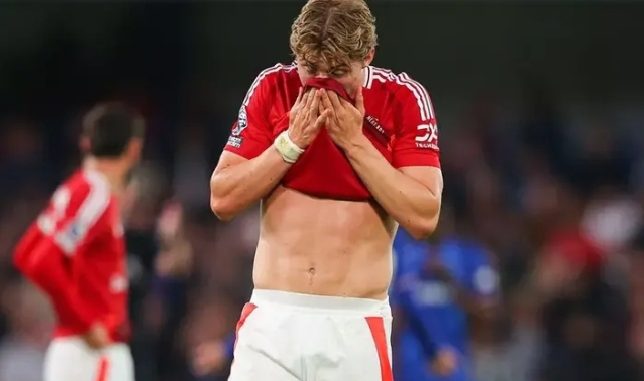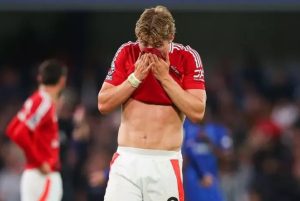
Rasmus Højlund’s Struggles Cast Doubt Over Manchester United’s £30m Transfer Plan
When Manchester United secured the signature of Rasmus Højlund in the summer of 2023 for a reported initial fee of £64 million (rising with add-ons), there was excitement and optimism around Old Trafford. The young Danish striker was seen as a long-term solution to the club’s No.9 dilemma — a physically imposing forward with pace, strength, and untapped potential. But after a turbulent debut season marred by inconsistency and adaptation challenges, Højlund’s struggles have not only raised questions about his own future but are now casting serious doubt over United’s £30 million transfer plan for the upcoming summer window.
Reports indicate that United have been eyeing a £30 million move for a secondary striker or backup forward to ease the burden on Højlund. However, with the 21-year-old yet to fully convince as a reliable Premier League marksman, that plan now seems uncertain. Instead of complementing Højlund, the Red Devils may now be forced to consider a bigger, more immediate investment in the striker position — possibly even someone to lead the line ahead of him.
Højlund’s Mixed Debut Season
To understand the concern, it’s important to assess Højlund’s first season in England. The striker had bright moments — including a purple patch in the winter months when he scored in five consecutive Premier League matches — showcasing his instincts in front of goal and chemistry with players like Bruno Fernandes and Alejandro Garnacho.
However, those moments have been few and far between. Across the full season, Højlund has been inconsistent, with long spells of goal droughts and games where he was completely isolated. In many matches, he appeared physically overwhelmed by Premier League defenders, struggling to hold the ball up or make the right runs.
In the Champions League, he was more productive early on, scoring five goals in the group stage. But his form in domestic competition lagged behind, leading to criticism about his overall impact in the team. Some of this is understandable — he is young, still developing, and playing in a Manchester United team that has suffered from injuries, tactical inconsistency, and lack of creativity from midfield. Yet the growing concern is whether Højlund is truly ready to be the main man at a club with Champions League ambitions.
A £30m Band-Aid?
Initially, United’s recruitment plan for summer 2025 included signing a striker in the £25–£30 million range — a seasoned, low-profile player who could rotate with or back up Højlund. Names like Serhou Guirassy, Jonathan David, and Joshua Zirkzee were floated — strikers who could come in to provide depth without displacing the Dane.
But Højlund’s uneven displays have prompted internal debate. Is signing a mid-tier striker enough? Would that just mask the real issue — that United may still lack a top-class, proven goalscorer capable of delivering 20+ goals in a Premier League season? If Højlund isn’t progressing fast enough, then signing a backup won’t solve the underlying problem — it merely postpones it.
There’s also the risk that bringing in a striker for that fee — who is good enough to play but not elite — could create positional ambiguity. Do you persist with Højlund and limit the new striker’s impact, or do you give the new player more minutes, potentially stalling Højlund’s growth?
The Pressure of the Price Tag
Part of Højlund’s current struggle comes from the expectations placed upon him. At £64 million, fans and pundits expected a near-finished product. But Højlund was always more of a project. At Atalanta, he only scored 9 league goals in his single season there. His fee was driven largely by potential, physical attributes, and his performances with the Danish national team.
Manchester United’s mistake, arguably, was failing to pair Højlund with a more established striker from the beginning. The plan to build around him was admirable but risky — especially in a club under constant scrutiny. It’s now evident that the club may have overestimated how quickly Højlund would adapt to the demands of English football.
This overreliance has exacerbated his issues. As the only natural striker in the squad, Højlund has had to play through fatigue, knocks, and dips in confidence, with no real option for Ten Hag to rest him. The mental toll of shouldering that responsibility at just 21 is visible.
Tactical and Structural Issues
It’s also important to contextualize Højlund’s performance within Manchester United’s tactical chaos this season. Injuries across the backline, inconsistent midfield setups, and lack of wide creativity have all contributed to a disjointed attacking unit.
Højlund thrives on service — he’s not a player who will drop deep like Harry Kane or create chances out of nothing like Erling Haaland. He needs runners, overlapping full-backs, and through balls. Too often this season, he has been feeding off scraps, relying on moments of individual brilliance rather than sustained team patterns.
This has led to frustration among fans and analysts, but it’s also prompted the club’s leadership — including new minority owner Sir Jim Ratcliffe and the incoming Ineos sporting team — to reconsider how they address the striker situation in the upcoming window.
What Are United’s Options Now?
With Højlund’s form under the microscope, United must reassess their £30m striker plan. They could:
1. Stick to the original plan: Sign a £25–£30m striker as a rotation option, keep faith in Højlund, and hope that better midfield recruitment helps both thrive.
2. Go big on a new No.9: Invest in a more proven, elite striker (e.g., Victor Osimhen, Ivan Toney) and allow Højlund to develop more gradually, perhaps as a second striker or impact substitute.
3. Promote from within or seek a short-term veteran: Look for low-cost, experienced forwards (like Olivier Giroud, who has played this role at other clubs) who can mentor Højlund without stalling his progress.
4. Loan Højlund? Though unlikely, some have even suggested a potential loan move abroad to help the Dane regain confidence and return sharper — though this would only be considered if a top-tier replacement arrives.
Fan Sentiment and Club Philosophy
The idea of spending another huge sum on a striker so soon after Højlund’s arrival doesn’t sit well with all fans. Many believe the issue lies not with the player, but with the lack of structure around him. United’s recruitment in midfield and on the wings — not to mention the tactical clarity of the system — must improve if any striker is to succeed.
However, with Ineos set to implement a more data-driven and performance-based model, pragmatism may trump sentiment. The club can’t afford another season of underperformance, and securing a proven goal-getter could become a necessity, not a luxury.
Conclusion: A Critical Decision Looms
Rasmus Højlund still has time to succeed at Manchester United. His physical attributes, attitude, and flashes of brilliance suggest that with patience and proper support, he could develop into a formidable striker. But the Premier League is ruthless, and United’s ambitions require more than potential — they require consistent output now.
The £30 million striker plan, once seen as a smart supplement to a rising star, now feels underwhelming. If Højlund’s struggles continue, United may be forced to rip up that strategy and aim higher — even if it means tough decisions about a player they once considered their No.9 for the future.
The coming months will be critical — not just for Højlund’s de
velopment, but for Manchester United’s entire attacking blueprint.

Leave a Reply